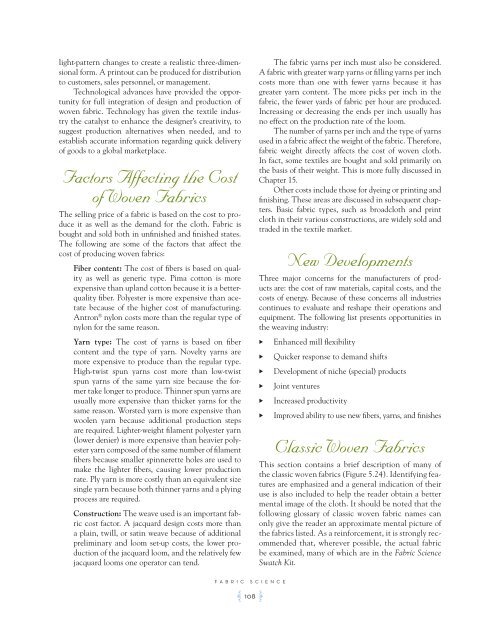Create successful ePaper yourself
Turn your PDF publications into a flip-book with our unique Google optimized e-Paper software.
light-pattern changes to create a realistic three-dimensional<br />
form. A printout can be produced for distribution<br />
to customers, sales personnel, or management.<br />
Technological advances have provided the opportunity<br />
for full integration of design and production of<br />
woven fabric. Technology has given the textile industry<br />
the catalyst to enhance the designer’s creativity, to<br />
suggest production alternatives when needed, and to<br />
establish accurate information regarding quick delivery<br />
of goods to a global marketplace.<br />
Factors Affecting the Cost<br />
of <strong>Woven</strong> <strong>Fabrics</strong><br />
The selling price of a fabric is based on the cost to produce<br />
it as well as the demand for the cloth. Fabric is<br />
bought and sold both in unfinished and finished states.<br />
The following are some of the factors that affect the<br />
cost of producing woven fabrics:<br />
Fiber content: The cost of fibers is based on quality<br />
as well as generic type. Pima cotton is more<br />
expensive than upland cotton because it is a betterquality<br />
fiber. Polyester is more expensive than acetate<br />
because of the higher cost of manufacturing.<br />
Antron ® nylon costs more than the regular type of<br />
nylon for the same reason.<br />
Yarn type: The cost of yarns is based on fiber<br />
content and the type of yarn. Novelty yarns are<br />
more expensive to produce than the regular type.<br />
High-twist spun yarns cost more than low-twist<br />
spun yarns of the same yarn size because the former<br />
take longer to produce. Thinner spun yarns are<br />
usually more expensive than thicker yarns for the<br />
same reason. Worsted yarn is more expensive than<br />
woolen yarn because additional production steps<br />
are required. Lighter-weight filament polyester yarn<br />
(lower denier) is more expensive than heavier polyester<br />
yarn composed of the same number of filament<br />
fibers because smaller spinnerette holes are used to<br />
make the lighter fibers, causing lower production<br />
rate. Ply yarn is more costly than an equivalent size<br />
single yarn because both thinner yarns and a plying<br />
process are required.<br />
Construction: The weave used is an important fabric<br />
cost factor. A jacquard design costs more than<br />
a plain, twill, or satin weave because of additional<br />
preliminary and loom set-up costs, the lower production<br />
of the jacquard loom, and the relatively few<br />
jacquard looms one operator can tend.<br />
FABRIC SCIENCE<br />
A 108 F<br />
The fabric yarns per inch must also be considered.<br />
A fabric with greater warp yarns or filling yarns per inch<br />
costs more than one with fewer yarns because it has<br />
greater yarn content. The more picks per inch in the<br />
fabric, the fewer yards of fabric per hour are produced.<br />
Increasing or decreasing the ends per inch usually has<br />
no effect on the production rate of the loom.<br />
The number of yarns per inch and the type of yarns<br />
used in a fabric affect the weight of the fabric. Therefore,<br />
fabric weight directly affects the cost of woven cloth.<br />
In fact, some textiles are bought and sold primarily on<br />
the basis of their weight. This is more fully discussed in<br />
Chapter 15.<br />
Other costs include those for dyeing or printing and<br />
finishing. These areas are discussed in subsequent chapters.<br />
Basic fabric types, such as broadcloth and print<br />
cloth in their various constructions, are widely sold and<br />
traded in the textile market.<br />
New Developments<br />
Three major concerns for the manufacturers of products<br />
are: the cost of raw materials, capital costs, and the<br />
costs of energy. Because of these concerns all industries<br />
continues to evaluate and reshape their operations and<br />
equipment. The following list presents opportunities in<br />
the weaving industry:<br />
u Enhanced mill flexibility<br />
u Quicker response to demand shifts<br />
u Development of niche (special) products<br />
u Joint ventures<br />
u Increased productivity<br />
u Improved ability to use new fibers, yarns, and finishes<br />
Classic <strong>Woven</strong> <strong>Fabrics</strong><br />
This section contains a brief description of many of<br />
the classic woven fabrics (Figure 5.24). Identifying features<br />
are emphasized and a general indication of their<br />
use is also included to help the reader obtain a better<br />
mental image of the cloth. It should be noted that the<br />
following glossary of classic woven fabric names can<br />
only give the reader an approximate mental picture of<br />
the fabrics listed. As a reinforcement, it is strongly recommended<br />
that, wherever possible, the actual fabric<br />
be examined, many of which are in the Fabric Science<br />
Swatch Kit.













